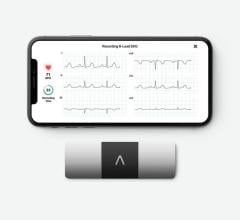
October 19, 2011 – A new study proves the importance of electrocardiographic (ECG) screenings to identify heart abnormalities in young adults, including both athletes and non-athletes. The study, published in the October edition of HeartRhythm, the official journal of the Heart Rhythm Society, demonstrates the success of a high-volume ECG screening program designed to identify potential life-threatening heart arrhythmias in high school students. Of the more than 32,000 students screened, ECG abnormalities that may be associated with the risk of sudden cardiac death (SCD) were identified in more than 800 students.
More than 250,000 deaths occur each year as a result of sudden cardiac arrest (SCA) and, more specifically, SCD occurs in an estimated 2,000 young adults annually in the United States.[1] While SCA among young adults is a serious concern, the primary challenge with ECG screenings on a large scale is the lack of efficiency and the likelihood for a large number of false positive results. The study, led by Joseph Marek, M.D., of the Midwest Heart Foundation, used a standardized and community-based screening program following strict quality controls and performed an average of 880 ECG screenings each day.
The screenings were performed during regular school hours in twenty-four Chicago suburban high schools between September 2006 and May 2009. In order to complete the study on a large scale, community volunteers participated in a successful and controlled training program. With the aid of the trained community volunteers, 32,561 students between the ages of 14 to 19, including athletes and non-athletes, were successfully screened.
Results showed that 817 (2.5 percent) of the 32,561 screened had ECG abnormities that could be associated with SCD. Specifically, left ventricular hypertrophy (LVH) was found in 141 participants, which may be associated with hypertrophic cardiomyopathy (HCM), the most common cause of SCD. In addition, 100 participants were found with Prolonged QTc that may indicate Long QT syndrome, which may also be associated with SCD.
“The screening process is an important step in trying to save lives because it helps us identify the individuals who are at the greatest risk of SCA and, ultimately, it has the potential to prevent incidents of sudden death from occurring,” said Marek. “As proof, some European countries have implemented successful screening programs in high volume that show great success in reducing SCA in young adults.”
In a study conducted in Italy over a 26-year period [2], ECG screenings in young athletes demonstrated an 89 percent reduction in SCD. It was proven that the incidence of sudden cardiac death in young competitive athletes substantially declined in the region of Italy where a nationwide systematic screening was introduced. Studies like this show that it is important to understand the preventative and implementable measures that can be taken to decrease the death rate of young adults from SCA.
“We believe our findings demonstrate the feasibility of performing high-quality, low cost ECG screenings in large U.S. populations which creates the potential to reduce the overall rate of SCD in our country,” said Marek.
For more information: www.heartrhythmjournal.com
1. Atkins, Dianne et al. "Epidemiology and Outcomes From Out-of-Hospital Cardiac Arrest in Children." Circulation. 2009 March 9; 119: 1484-1491.
2. Corrado, Domenico et al. "Trends in Sudden Cardiovascular Death in Young Competitive Athletes After Implementation of a Preparticpation Screening Program." JAMA. 2006: 296 (13):1593-1601.


 November 21, 2023
November 21, 2023 








